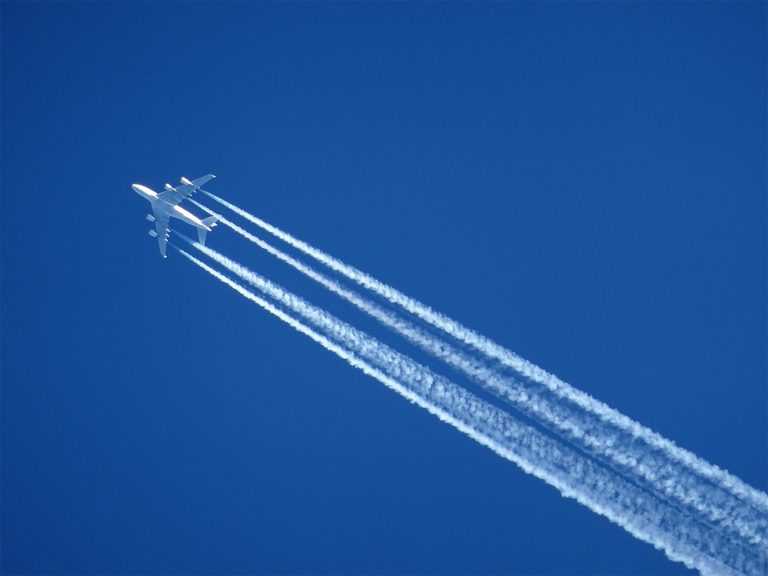

If you have ever glimpsed a jet zipping through the air, you may have noticed a thin white line streaming from the back of it. These white lines are referred to as contrails - an abbreviation for condensation trails. The reasoning behind why these "sky art" lines are formed can be explained with the analogy of why you can see your breath in the air at certain times. The water vapor present in the jet exhaust condenses and could freeze. This combination process forms a cloud comparable to the one your hot breath forms on a cold day.
Well, contrails are long, condensed trails that are visible in the upper atmosphere behind jet engines. Since the beginning of jet aviation, they have been a common occurrence. Their duration and size vary almost entirely on the temperature and humidity of the air at the plane's altitude. The water content in persistent contrails mainly comes from the atmosphere, but it also comes from the exhaust of the plane.
The creation of contrail ice crystals begins with minuscule particles made from soot or other materials generated by aircraft exhaust. This process involves the coalescence of a few dozen to several hundred molecules, which then combine to form more substantial particles. The surfaces of these particles are made of sulfates and nitrates. Their growth is enabled by the presence of water vapor in the exhaust gases and ambient relative humidity greater than 100%.
Unlike those clouds that form without any human intervention, contrails are a result of the exhaust from planes. They are generally made up of ice particles, as opposed to normal clouds, which are usually composed of liquid droplets. Furthermore, these clouds can only take shape at very high altitudes where the temperature is very low, whereas natural clouds can form at different heights, ranging from the ground (fog) up to the sky (cirrus clouds).

Three distinct types of contrails exist, but all of them are composed of the same two components and are generated in the same way. The difference between them lies in the persistence of the contrail.
Short-Lived Contrails, for example, appear as brief white streaks in the wake of the aircraft and soon vanish practically as soon as the plane passes across the sky. Usually, these kinds of contrails last a few minutes at most before water vapor reverts to gas. In this case, the air mass that the plane flies through is quite dry, with only a tiny amount of water vapor creating the contrail.
Non-spreading persistent contrails are visible as long white lines that stay behind after the plane has passed by. For this kind of contrail to form, there must be a humid and damp atmosphere with a lot of water vapor or nuclei. Because of the added moisture, the ice needs far more time to melt, which makes the contrail visible for up to an hour after the aircraft has left.
The process of forming persistent contrails is similar to the non-spreading type. However, the diffusion of thick contrail streaks is caused by an unsteady or turbulent atmosphere. As a result, they are distributed over a wider area, which gives them an aspect more like that of a cloud.
Thermodynamics dictates the formation of contrails. This is explained by a mathematical equation that considers the temperature and pressure of the atmosphere, the humidity, the water content in the exhaust, and other variables. When the relative humidity exceeds 100%, the contrails can last for several minutes to hours, forming elongated narrow trails in the sky.
Occasionally, the jets will expand both vertically and horizontally due to turbulent air in the atmosphere - covering a wider area in the sky. This is dependent on the amount of water vapor available at cruising altitude. This produces cirrus clouds composed of ice particles that may last for several hours, similar to normal cirrus clouds.
The presence of contrails in the atmosphere is expected to change if any of the factors that influence their formation and duration are altered. These crucial elements include the type of engines used in aircraft, the level and position of air traffic, and the humidity levels in the background atmosphere. For instance, if fuel efficiency is improved, this could cause changes in the heat and amount of water released in the exhaust. This could influence the frequency and extent of contrails. Alterations in air traffic may also impact persistent contrail formation.
It is estimated that around 16 percent of the Earth's area contains an atmosphere with sufficient humidity to produce persistent contrails. If air traffic increases in these areas, the number of persistent line-shaped contrails will also rise. After considering current meteorological information, projected air traffic growth, and technological developments, it is anticipated that the presence of persistent contrails will become more common between now and the year 2050.
Affiliate Partner Program | Jobs at Spartan | Privacy Policy | Opt-out Policy | Privacy Notice - California Residents| Notice of Non-Discrimination | Website Accessibility Help | Transparency in Coverage Act
© 2024 SPARTAN COLLEGE OF AERONAUTICS AND TECHNOLOGY. ALL RIGHTS RESERVED.